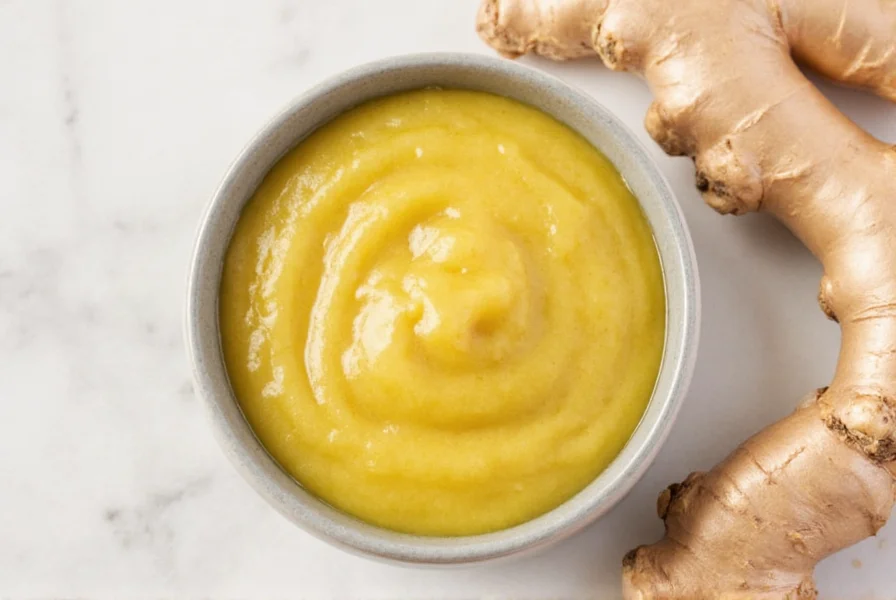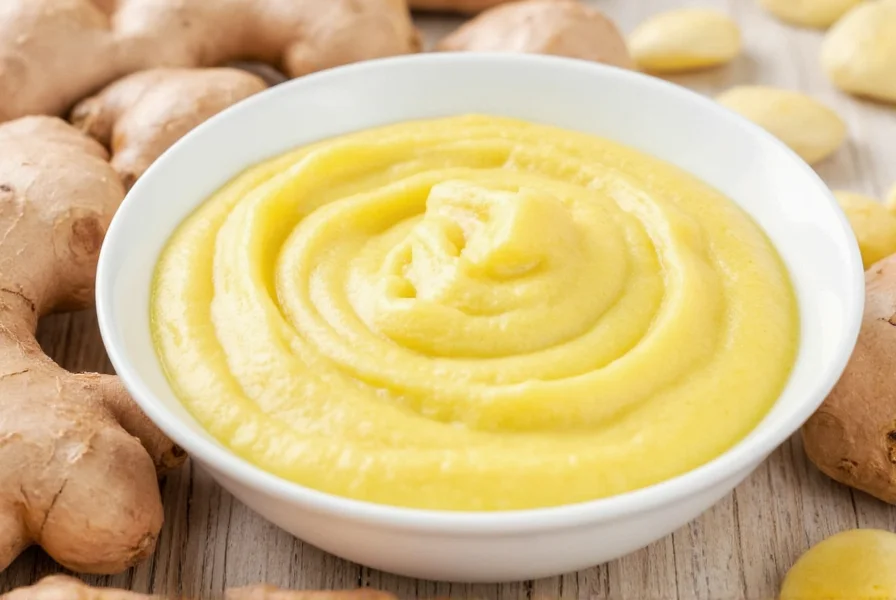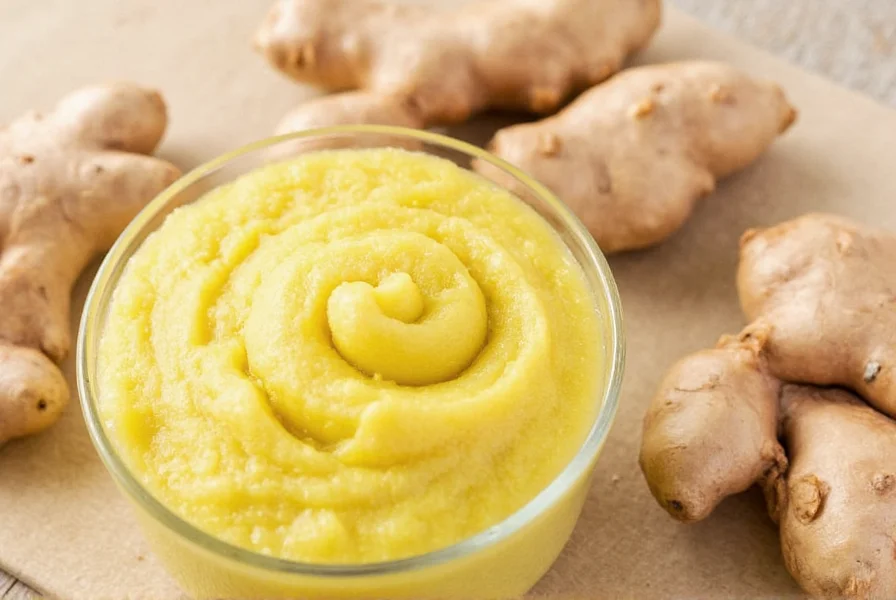Ginger puree has become increasingly popular among home cooks and professional chefs seeking consistent ginger flavor without the hassle of peeling and grating fresh root. Unlike powdered ginger or ginger paste with additives, pure ginger puree contains only one ingredient: ginger. This versatile ingredient delivers the authentic spicy-sweet warmth of fresh ginger in a convenient, shelf-stable form that integrates seamlessly into both sweet and savory applications.
What Exactly Is Ginger Puree?
Ginger puree represents the unadulterated essence of fresh ginger root processed into a smooth, pourable consistency. Manufacturers create it by thoroughly washing, peeling, and blending mature ginger rhizomes until achieving a uniform texture without fibrous bits. The resulting product maintains ginger's characteristic pungency and complex flavor profile while eliminating the textural inconsistencies found in hand-grated ginger.
The production process significantly impacts quality. Premium ginger puree undergoes minimal processing—typically just mechanical blending without heat treatment that could degrade volatile compounds responsible for ginger's distinctive aroma. This careful handling preserves gingerol, the primary bioactive compound in ginger that provides both its signature heat and potential health benefits.
Ginger Puree Compared to Other Ginger Forms
| Ginger Form | Texture | Flavor Intensity | Shelf Life | Best Uses |
|---|---|---|---|---|
| Fresh Ginger Root | Fibrous, requires peeling | Moderate to strong | 2-3 weeks refrigerated | Stir-fries, teas, grating |
| Ginger Puree | Smooth, pourable | Consistent, robust | 6-12 months unopened | Sauces, marinades, baking |
| Ginger Paste | Thick, often contains oil | Variable (may include additives) | 3-6 months refrigerated | Curry bases, spice blends |
| Ground Ginger | Dry powder | Milder, less complex | 2-3 years | Baking, spice mixes |
Creating Homemade Ginger Puree
Making ginger puree at home ensures complete control over quality and freshness. Start with firm, plump ginger roots featuring smooth skin and minimal wrinkles. Younger ginger typically yields a more vibrant puree with less fibrous texture.
- Peel ginger using a spoon to minimize waste (the edge glides perfectly between skin and flesh)
- Cut into 1-inch chunks for easier processing
- Blend with minimal water (1-2 tablespoons per cup of ginger) until completely smooth
- Strain through fine mesh if absolute smoothness is required
- Store in airtight container with thin oil layer to prevent oxidation
For extended shelf life, freeze homemade ginger puree in ice cube trays then transfer to freezer bags. Each cube typically contains one tablespoon, making portioning for recipes effortless. Properly stored, frozen ginger puree maintains quality for 6-12 months.

Optimal Culinary Applications for Ginger Puree
Ginger puree shines in applications where uniform flavor distribution matters. Its smooth texture integrates seamlessly into liquids without leaving fibrous bits, making it ideal for:
- Marinades and dressings - Creates emulsified sauces without textural interference
- Baking - Distributes evenly in batters for consistent ginger flavor in cakes and cookies
- Beverages - Mixes perfectly into smoothies, cocktails, and hot teas
- Soups and stews - Blends invisibly while delivering robust ginger notes
- Preserves - Adds complexity to jams and chutneys without texture issues
When substituting ginger puree for fresh ginger, use a 1:1 ratio by volume. One tablespoon of puree equals one tablespoon of freshly grated ginger. For ground ginger substitutions, use three parts ginger puree for every one part powder, as dried ginger concentrates flavor through moisture removal.
Storage Guidelines for Maximum Freshness
Commercial ginger puree typically remains shelf-stable until opened due to pasteurization. After opening, refrigerate and use within 3-4 weeks for optimal flavor. Homemade versions require refrigeration immediately and last approximately 2 weeks when stored in airtight containers with a protective oil layer on the surface.
Freezing represents the most effective long-term storage method. Portion puree into tablespoon measurements using ice cube trays, then transfer frozen cubes to labeled freezer bags. This approach prevents freezer burn and allows precise measurement for recipes. Thaw frozen ginger puree overnight in the refrigerator or add directly to hot preparations.

Understanding Ginger Puree Substitutions
Knowing proper substitution ratios prevents recipe failures when ginger puree is your only option. The moisture content significantly affects substitution calculations:
- Fresh ginger to puree: 1:1 ratio (1 tbsp fresh = 1 tbsp puree)
- Puree to fresh ginger: 1:1 ratio (works in most applications)
- Puree to ground ginger: 3:1 ratio (3 parts puree = 1 part powder)
- Dried ginger to puree: Reverse the 3:1 ratio (1 part dried = 3 parts puree)
When converting recipes originally designed for dried ginger, remember that ginger puree adds moisture. Reduce other liquids by 1-2 teaspoons per tablespoon of puree substituted to maintain proper recipe consistency, especially in baking applications.
Frequently Asked Questions
Can I use ginger puree instead of fresh ginger in all recipes?
Yes, ginger puree works as a 1:1 substitute for fresh ginger in nearly all applications. The primary difference is texture—puree integrates completely without fibrous bits, making it ideal for smooth sauces, beverages, and baked goods where visible ginger pieces would be undesirable.
How long does homemade ginger puree last in the refrigerator?
Properly stored homemade ginger puree remains fresh for 10-14 days in the refrigerator. To maximize shelf life, store in an airtight container with a thin layer of neutral oil (like grapeseed) covering the surface to prevent oxidation. Always use clean utensils when scooping to avoid contamination.
Does ginger puree have the same health benefits as fresh ginger?
Ginger puree retains most bioactive compounds found in fresh ginger, including gingerols responsible for its characteristic heat and potential anti-inflammatory properties. Minimal processing preserves these compounds better than dried ginger, though some volatile aromatics may diminish over time in stored puree compared to freshly grated root.
Why does my ginger puree separate in the jar?
Separation occurs naturally in ginger puree due to settling of fibers and liquid components. This is completely normal and doesn't indicate spoilage. Simply stir thoroughly before each use to recombine the elements. Commercial products may contain stabilizers to prevent separation, but pure ginger-only versions will naturally separate over time.
Can I make ginger puree from dried ginger?
No, dried ginger cannot be reconstituted into true ginger puree. The dehydration process fundamentally changes the cellular structure and concentrates flavors differently. For authentic ginger puree, you must start with fresh ginger root. Dried ginger works better when converted to powder rather than attempting to create a puree substitute.











 浙公网安备
33010002000092号
浙公网安备
33010002000092号 浙B2-20120091-4
浙B2-20120091-4